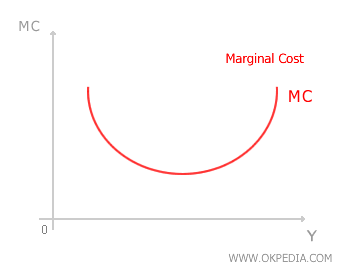Marginal Cost
Marginal cost refers to the additional expense incurred when producing one more unit of output. In other words, it represents the cost of the last unit produced. Marginal cost captures, in a precise and incremental way, how total costs change as output increases. To fully understand this concept, it's helpful to examine its mathematical formula and graphical representation.
The Marginal Cost Formula
Mathematically, marginal cost is defined as the ratio of the change in total cost (ΔC) to the infinitesimally small change in output (ΔY).

From a graphical perspective, the marginal cost function (MC) is represented by the first derivative C' of the cost function. This derivative corresponds to the slope of the total cost curve at any given point. In formal terms, this relationship is expressed as:

The Marginal Cost Curve
The marginal cost function (MC) can be plotted on a Cartesian plane, where marginal cost is mapped against the level of output (Y). The distinctive U-shape of the marginal cost curve is directly linked to the marginal productivity of production inputs.

The U-shaped behavior of the marginal cost curve is a reflection of how input productivity changes over different levels of output. The economic reasoning behind the downward and upward slopes of the curve is as follows:
- Decreasing phase: At lower production levels, the marginal cost curve slopes downward because adding more inputs improves the efficiency of the production process. During this phase, the marginal product of inputs is increasing, meaning that each additional unit of input contributes more to output.
- Increasing phase: After reaching its lowest point, the marginal cost curve begins to rise. At this stage, additional inputs become less effective, reducing overall efficiency. The marginal product of inputs declines, meaning more resources (e.g., labor, raw materials) are required to produce each extra unit of output. This diminishing returns effect drives up marginal cost in the later stages of production.
 Variable Costs: The marginal cost curve reflects only variable costs, as fixed costs remain unchanged regardless of output levels (ΔY). This means that any increase in total cost (ΔC) is entirely due to rising variable costs associated with production.
Variable Costs: The marginal cost curve reflects only variable costs, as fixed costs remain unchanged regardless of output levels (ΔY). This means that any increase in total cost (ΔC) is entirely due to rising variable costs associated with production.
 Marginal Cost vs. Average Cost: Marginal cost (MC) specifically measures the cost of producing an additional unit of output (ΔY) and the corresponding increase in variable costs (ΔC). In contrast, average cost (also known as unit cost) considers total output (Y) and accounts for both variable costs (VC) and fixed costs (FC). While marginal cost reflects incremental changes, average cost provides a broader measure of cost per unit across the entire production scale.
Marginal Cost vs. Average Cost: Marginal cost (MC) specifically measures the cost of producing an additional unit of output (ΔY) and the corresponding increase in variable costs (ΔC). In contrast, average cost (also known as unit cost) considers total output (Y) and accounts for both variable costs (VC) and fixed costs (FC). While marginal cost reflects incremental changes, average cost provides a broader measure of cost per unit across the entire production scale.
